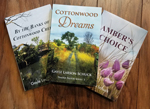I’m of the Old School
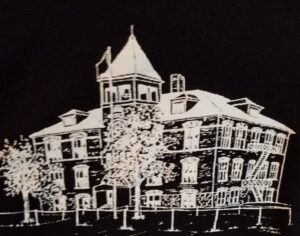
Old School
Perhaps I’m old school because I attended the Old School when I was growing up. It was a square brick building with a bell tower and three floors. The wooden stair steps had indents from decades of young feet tramping up and down them. Each fall the newly shined hardwood floors smelled like polish.
I lived across the street, and so the school grounds were my playground. On summer nights, the neighbor kids played baseball there. On mild days, we used the iron bar fence along State Highway 13 as a balance beam. I still remember rambling across the snow-crusted schoolyard with the boy next door after a school dance.
In the main hall of the school, a statue of Abraham Lincoln greeted students as they came up the steps. To a little kid from a small town, the statue was large in meaning.
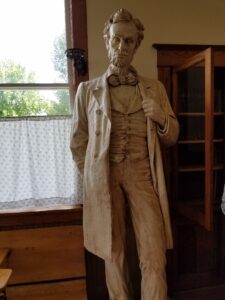
Old Abe in his new home
Old Abe reminded me that even a poor boy from the frontier could grow up to be president. He was known for his honesty. He was a champion of freedom.
Some people appear to be ignorant of Lincoln’s accomplishments and sacrifice for us, U.S. They desecrate and tear down statues of Lincoln. They point out his flaws and miss the obvious fact that he changed history for the good of all of us.
To me, the statue will always be linked with the ideals that were instilled in us as students. This month, President’s Day falls a few days after Lincoln’s birthday. It’s a great time to think of how much he helped our nation. Yes, we have our problems. Still, people all over the world dream of moving here. That’s because of, not in spite of, the leadership of people like Abraham Lincoln.
Lincoln delivered the Gettysburg Address on the battlefield during the Civil War. That battle was the turning point in the war for freedom from slavery.
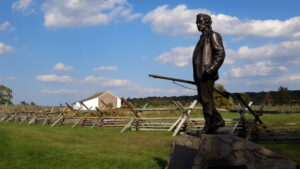
The Gettysburg Battlefield today
The Gettysburg Address still identifies the heart of America. Please take a moment to read through its 278 words which are still relevant today.
Four score and seven years ago our fathers brought forth on this continent, a new nation, conceived in Liberty, and dedicated to the proposition that all men are created equal.
Now we are engaged in a great civil war, testing whether that nation, or any nation so conceived and so dedicated, can long endure. We are met on a great battle-field of that war. We have come to dedicate a portion of that field, as a final resting place for those who here gave their lives that that nation might live. It is altogether fitting and proper that we should do this.
But, in a larger sense, we can not dedicate — we can not consecrate — we can not hallow — this ground. The brave men, living and dead, who struggled here, have consecrated it, far above our poor power to add or detract. The world will little note, nor long remember what we say here, but it can never forget what they did here. It is for us the living, rather, to be dedicated here to the unfinished work which they who fought here have thus far so nobly advanced. It is rather for us to be here dedicated to the great task remaining before us — that from these honored dead we take increased devotion to that cause for which they gave the last full measure of devotion — that we here highly resolve that these dead shall not have died in vain — that this nation, under God, shall have a new birth of freedom — and that government of the people, by the people, for the people, shall not perish from the earth.
Abraham Lincoln
November 19, 1863
The Lincoln statue from the Old School is now located at the LaMoure County Memorial Museum at Grand Rapids, N.D. You can find the link to the museum on Facebook.
Writing Update:
I’m editing the manuscript of Cottonwood Dreams and wishing I could make a road trip to Cottonwood Creek. I’d stay at Kate’s Bed & Breakfast and gas up at Your Friendly Co-op. Then I’d drive out to Cottonwood Church and snap a few photos.
Speaking of which, I am looking for good photos of a North Dakota blue sky over a sunflower field. If you know of any, please contact me.
“Some old-fashioned things like fresh air and sunshine are hard to beat.”
– Laura Ingalls Wilder
New Year, New Book
“Joyful, joyful, we adore thee, God of glory, Lord of love. Hearts unfold like flowers before Thee, opening to the sun above.” These words have been marching through my mind for the past two weeks as I finish my next book.
This New Year’s, the book is one chapter away from being finished and it still didn’t have a name!
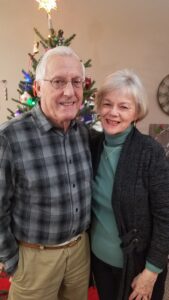 On New Year’s Eve, with three naming ideas in hand, I went to my husband for advice. This man has read every chapter as it comes off the printer all raw and flawed. He’s caught typos and flagged problems. He’s laughed and cried over my words. Of course, my writers group has done this, too, but my husband has also dealt with the words, “Just another ten minutes” too many times as I finish a paragraph, and has driven me all over the Dakotas for book signings.
On New Year’s Eve, with three naming ideas in hand, I went to my husband for advice. This man has read every chapter as it comes off the printer all raw and flawed. He’s caught typos and flagged problems. He’s laughed and cried over my words. Of course, my writers group has done this, too, but my husband has also dealt with the words, “Just another ten minutes” too many times as I finish a paragraph, and has driven me all over the Dakotas for book signings.
I picked out three titles for the book and had sort of decided on one. However, I wanted his opinion. Without hesitation he chose the third one, the very one I had landed on.
Today, I’m sharing with this select audience the title of my next book:
Cottonwood Dreams
There’s a long way to go before Cottonwood Dreams is finished. The publishing process may take another year. After the last chapter is written, editing and revisions begin. Eventually it will be proofread. A cover will be designed. Then comes the actual launch. Sometimes I feel too old to do all of this, but then I remember one of my favorite authors, Laura Ingalls Wilder, began publishing Little House books at age 64.
Cottonwood Dreams is the last book in the Prairie Pastors Series. For 20 years, the characters of series have lived in my heart and mind. By the time By the Banks of Cottonwood Creek was finished, Kelly, Amber, Tiny and Brianna took on lives of their own, and Amber’s Choice was on it’s way.
Here is the synopsis of Cottonwood Dreams:
Can a couple as different as chalk and cheese make a relationship work? That’s what Brianna Davis wonders when, in an unlikely turn of events, Tiny Winger captures her heart and she moves across the country to Cottonwood Creek. She wants to escape from her life in San Francisco, but is their love strong enough to heal the hurts of the past?
Tiny has overcome childhood abuse and neglect with the help of God and the good people of Cottonwood Creek. Now he dreams of a life with Brianna. Only two things block the way to true happiness: their mothers.
How to Live Well in 2021
Going into the new year with a song in my heart is certainly a gift from God that contradicts my personal concerns and the state of the world.
It is the second time music has been a muse for my writing. Six years ago on New Year’s Eve, as I wrote the last chapter of Secrets of the Dark Closet, the hymn This is my Father’s World played in my head and lifted my soul and spirit.
A muse is a “source of inspiration.” The song Joyful, Joyful is based on a poem written by Henry Van Dyke to go with a melody composed by Ludwig van Beethoven. The above words are the first lines in verse one. There are four verses.
Music is a source of inspiration for all of us, lifting moods on dreary days and brightening our outlook on the world. Several of my friends picked special words to reflect on this year and encouraged me to do the same. My word will be “Sing.” I hope you will “join the band” and pick a word to inspire you in 2021.
I wanted to offer some ideas for living well in the new year, but my friend Barbara Brabec beat me to it. These ideas are shared with her permission. Find more in The Brabec Bulletin brabec-bulletin@wowway.com.
* Live one day at a time and don’t worry about tomorrow, since “. . . tomorrow will worry about itself. Each day has enough trouble of its own” (Matt. 6:34).
* Ground myself in the Word, thank God for each new day I’m given, and find something to be grateful for each day.
* Stay informed about what’s happening in America and the world at large, but avoid “negative news overload.”
* Continue to find joy in my work and interactions with friends and family. Be helpful to others, and do what I can with what God has given me for this purpose.
* Prudently plan for my future, dream of new things I want to do, set goals I can realistically achieve, and never take my family, friends, and God-given skills and talents for granted.
God Bless You Richly in the New Year!
About Those Christmas Traditions
Go to www.gaylelarsonschuck.com/blog
 As Christmas draws near, I’m indulging in some traditions. The Santa card that Aunt Mary and Uncle Art sent me when I was four is hanging on the tree. My mother wrote our sons’ names on it when she sent it one Christmas many years ago. Other traditions include making frosted sugar cookies, sending cards and exchanging gifts with family.
As Christmas draws near, I’m indulging in some traditions. The Santa card that Aunt Mary and Uncle Art sent me when I was four is hanging on the tree. My mother wrote our sons’ names on it when she sent it one Christmas many years ago. Other traditions include making frosted sugar cookies, sending cards and exchanging gifts with family.
Laura Ingalls Wilder said, “Our hearts grow tender with childhood memories and love of kindred, and we are better throughout the year for having, in spirit, become a child again at Christmastime.”
However, let’s not get too sentimental about Christmas traditions. Some of them disappeared with good reason. Clearly, Laura wasn’t forced to eat oyster stew, lutefisk and lefse for Christmas Eve supper. It’s a good thing we also hand cranked homemade ice cream for dessert or I would have starved.
Apparently, my brothers and sisters were like-minded about those traditional Norwegian dishes. By the time I was nine and we moved to town, my siblings were married and had families. Everyone gathered at our house for assorted meats, salads, and Christmas cookies. Dad lobbied for lutefisk and lefse every year, but they were no longer the main meal. Oyster stew vanished.
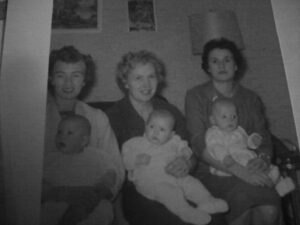
Babies Scott, Kathy & Ed with their moms
By then, our small house was packed every Christmas Eve with up to thirty adults and children. In 1960 there were three infants present! More mobile red-cheeked kids ran around in their Christmas outfits, cookies in hand. Adults imbibed in eggnog and my brothers told stories that drew hardy laughter.
By nine ’o clock, the house would be eighty degrees and the decibel level even higher. That’s when I’d fight my way through the mob and slip outside.
The night would be silent, the air refreshing and cold and the sky lit by a million stars. Walking around the neighborhood alone, the words “silent night, holy night” became reality. Not a single car was driving around. Even the wind was quiet in the presence of the same glorious night sky the shepherds had seen.
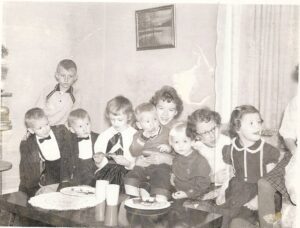
A Polaroid taken a couple years later. Me with of some nieces and nephews, including those babies
Those Larson Christmases make fond memories now. They were followed by Christmases with the Schucks, which were just as boisterous and included homemade pickled pig’s feet and deep fried chicken gizzards. And, oddly, the stomach flu often went through the family during the holidays.
Today, our Christmas Eves are much quieter. If the weather is good, we attend a lovely candlelight service at church. The next day we feast and open gifts with our children and grandchildren. (The menu doesn’t include oyster stew or pickled pigs feet.)
Although times change, the memories and the traditions we keep are a way to hug the people we love when they are no longer with us.
And perhaps it’s good that traditions evolve. I like the saying “Blessed are the flexible for they shall not be bent out of shape.” That point of view has certainly made this Covid 19 year easier.
There is one tradition that we can follow regardless of time, distance or pandemics, and that is to open our hearts to the original Christmas baby, our Lord Jesus. My prayer for you is that you find time to ponder the hope that He brought and still brings.
It was He that said in Matthew 28:20, “And surely I am with you always, to the very end of the age.” Notice he said, “I am with you.” Now. In this present moment, we have the gift of his presence. We only need to stop and realize how he can sustain our hearts with hope and joy.
What Christmas traditions do you follow? Which ones have you left behind?
Writing Update: I’ve been working on a sequel to “By the Banks of Cottonwood Creek” and “Amber’s Choice.” Here’s the synopsis:
Can a couple as different as chalk and cheese make a relationship work? That’s what Brianna Davis wonders after she moves to Cottonwood Creek when in an unlikely turn of events, Tiny Winger captures her heart. But is love enough to conquer the hurts of the past?
Tiny Winger has overcome the abuse and neglect of his childhood with the help of God and the good people of Cottonwood City. Now he dreams of a life with Brianna Davis.
Only two things block the way: his mother and Brianna.
What do you think? Your comments are welcome.
Merry Christmas and God bless you!
The Christmas Catalog
I know, I know. I should dish about the election or Covid, or wax eloquent about Thanksgiving. 
But I’m tired of being a grownup. I want to read a Christmas catalog and imagine finding a Sassy Walker under the Christmas tree.
The Sears, Penneys and Monkey Wards Christmas catalogs were the online shopping of the 20th century and provided hours of entertainment. They featured holiday clothing for the whole family. Red and green dresses, sweaters and suits for the guys, and matching pajamas for the whole family.
One of my classmates remembers when she found a dress she liked, her mother would cut a pattern out of newspaper and sew a similar outfit. What a great memory! Some readers remember cutting out the models to use as paper dolls. Thank you Karen, Carol, Bonnie, Brian, Larry, and Sandi for sharing your experiences.
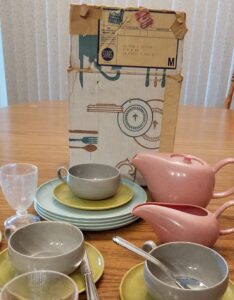
Toy dishes, postmarked 1958
Personally, I flipped through the clothing and got to the toys. As a young girl most of my playmates were neighbor boys. Perhaps that’s why I liked the cowboy guns and toy farm sets. However, they weren’t as great as the dolls and the stuff needed to keep dolls dressed and fed.
My husband recalls wanting a bicycle in the Christmas catalog. Not just any bike, but a lightweight J.C. Higgins 3-speed. He cleaned the barn quite a few times for that “gift.” The bike was shipped from France and cost a total of $38.65. When it arrived by freight train, a neighbor picked it up and brought it to their farm. He still rides bicycle, though not the same one, which would probably be worth a mint today.
The words “Christmas catalog” seem to bring instant memories to several generations. For instance, one of our sons recalls that he spent hours memorizing the electric train section. Actually, both of our sons did. As adults, they still enjoy model railroading.
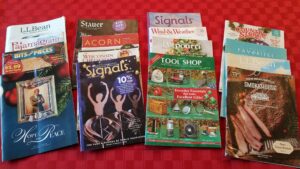
21st Century Catalogs
Catalogs of the 21st century are smaller and more plentiful. Recently we received one that featured a family wearing matching pajamas, and even the dog had a matching set. We get a lot of catalogs now, but I hope my family doesn’t order anything for me. I really don’t want a t-shirt that states, “I lived through the 60s. Twice”, or a collectible mouse or an overpriced puzzle.
So what do you think? Did this post take your mind off politics and Covid for a few minutes? It did mine.
Recently I began leading a Bible study called Growing in Wisdom & Faith by Elizabeth George. It’s based on the book of James, who said right up front in the second verse of the first chapter, “Count it all joy when you fall into various trials, knowing that the testing of your faith produces patience.”
The truth is we will always have problems and trials. The Life Application Study Bible says we can’t really know the strength of our character until we see how we react under pressure. And friends, it’s when we see God as bigger than our trials, we can find joy in spite of circumstances.
“Joy is the holy fire that keeps our purpose warm and our intelligence aglow.” Helen Keller
Writing Update
I’m “counting it all joy” and learning to be patient this year. Our writers group is meeting again and I’m working on Chapter 31 of…something.
All of my books are for sale online, or contact me personally if you want a signed copy. People tell me they make great gifts. If you order “Secrets of the Dark Closet” please order the second edition and pay less.
At Home with Covid
 Peace I leave with you; my peace I give you. I do not give to you as the world gives. Do not let your hearts be troubled and do not be afraid. John 14:27
Peace I leave with you; my peace I give you. I do not give to you as the world gives. Do not let your hearts be troubled and do not be afraid. John 14:27
My husband, Larry, dropped a little scripture card on my desk last summer. It was pretty, but I was preoccupied and didn’t bother to read it. I should have. Weeks later, I picked it up and it seemed like a message from God himself: Let not your heart be troubled.
That same week, on Sept. 15, Larry tested positive for Covid-19. We spent September with the unwelcome visitor.
The first two days were busy. The doctor and the state health department called. We notified family and canceled all our plans. Then on Sept. 21, I also tested positive.
That day, the health department determined our 10 days of quarantine to be over on Sept. 22 as long as our temperatures were under 100.4. Oh really? Our temperatures never did reach 100.4 and I was just beginning to feel sick. We both ran low-grade fevers, lost our appetites and ached all over. Larry had a cough and lost his sense of taste. Any small exertion makes my lungs hurt.
We decided to trust our own judgement on whether we were contagious, and we stayed home.
My faith was being tested, too. My heart was troubled in spite of the message on the little card and the health department’s blithe determination. However, I couldn’t think about it for long, because it was hard to stay awake—another symptom.
People assured us: Don’t be afraid, this too shall pass. But loneliness lurked between those moments of feeling loved. We were in Covid Limbo. The health department said we were good to go, but we weren’t. I began to cry over every kind word and deed, and sometimes for no reason at all. It became clear why isolation makes people vulnerable to addictions and mental health issues.
The kids delivered groceries. When we missed our grandson’s birthday party, the guys brought over homemade cake and stood nervously outside our door for a few moments. Our bachelor neighbor sent over a meal, which helped when we had no energy to cook. Eighty-five people sent prayers and good wishes when I posted on Facebook.
We are humbled by your kindness and appreciate every prayer, good thought or deed.
We are now recovering, healing on the wings of your prayers, and not taking good health for granted. Relief began a few days ago when I felt normal for a few hours before sinking into the aches and nausea again. Then yesterday, Larry had enough energy to run errands. I began feeling more normal for longer periods of time. I still feel weak and tired, but we’ve survived!
We will cautiously resume more activities. But we have many questions. How long does immunity last? Are we more susceptible to colds and flu? When will our energy return?
Here are some things for you to consider:
- Don’t take Covid-19 lightly. We had mild cases, but we haven’t felt good enough to go anywhere for weeks.
- Do social distance when you are out and about. Give everyone space for their sakes and for yours.
- Don’t overload your agenda. We only saw a couple people in the days from when we were exposed to when we tested positive. They both had to quarantine! Happily, neither got Covid.
- Do reach out to those who have Covid. Cards, emails, phone calls, or running an errand for someone can mean so much.
- Don’t let your supplies run low. Nearly out of toothpaste, postage stamps, cough medicine, books, popcorn? Stock up. Think what you need to live comfortably for a month without going out.
- Do find ways to be joyful. Laughter is good medicine. It’s also a way to say you trust God even when trouble comes your way.
Writing Update
Am I writing? Do ducks fly? Of course, I am. Even with Covid, I’ve spent a lot of time at Cottonwood Creek, where the world is a gentler, kinder place, but stuff happens.
Help! On March 20, 2020, I republished Secrets of the Dark Closet as a Second Edition. It can be found at online stores for $14.99 and the eBook is just $4.99. Make sure you order the second edition. ISBN number 978057866. You can also order signed copies directly from me. Please pass the word to others.
It’s a thorn in my side that the first edition is still available online for varying prices. For instance, someone in Australia is selling it for $29.03 US. My other books are also being sold by resellers for a variety of prices. Buyer beware.
Canning Season
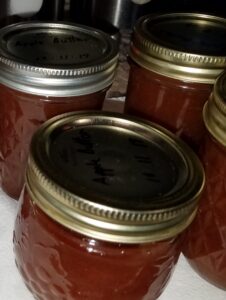
Apple Butter
Here in North Dakota, we have five seasons: winter, spring, summer, fall, and canning season. Recently, when it was 98 degrees outside, a friend spent the day in the kitchen making beet pickles. Her joy in the finished product reminded me of my own canning roots.
However, I must confess I’ve only made pickled beets once. Here’s how you do it: First, you dig them out of the garden. Then they must be cleaned, boiled, peeled and sliced before the pickling process begins. When I got to that stage, I realized that beet juice makes wonderful dye for hands, clothes and the whole kitchen.
We had no air conditioning in those days and the windows were open. I could hear the kids having fun as they ran through the sprinkler. I considered dumping the whole beet project and joining them, especially after I found out an ingredient was missing. However, duty called, so I loaded the wet kids in the car for a trip to the store, where I walked past the jars of beet pickles to get to the spice aisle.
Another canning story happened on a steamy August day. Mom was canning green beans in our farm kitchen. I was sent outside to hang around with Dad. To summarize, let’s just say I was seven year old with very good intentions when I put the pickup in reverse and drove over the junk pile.
When the pickup finally stopped, all four tires were flat, and there was a cream can wedged under the front bumper. (You just can’t make up details like that, can you?) Anyway, Dad sent me to the kitchen to confess to Mom, who turned off the gas stove, released the pressure valve on the canner, and came outside to help pry the pickup out. For the rest of the afternoon, I sat on the shop step and listened to Mom bawl me out as they sweated over the mess I made.

Our garden has flowers and veggies, but no beets
Although, I haven’t driven a pickup in years and no longer do much canning, when I do I think of Mom and the beans. Today, my summer tradition is limited to occasional batches of corn relish, apple butter, salsa, or cherries. In a good apple year, there will also be apple pies in the freezer.
We are blessed to have an abundant supply of fresh fruits and vegetables from all over the world, something I couldn’t have imagined as a child. I hadn’t actually seen empty grocery shelves in decades, until the coronavirus appeared. It made me appreciate what many people in the world deal with on a regular basis.
For most of history, food was locally grown. People raised their own meat, grain, veggies and fruits. Late summer and fall were dedicated to bringing in the harvest and preserving it. Many homes had a storehouse or cellar that could hold a winter’s worth of potatoes, carrots, squash, and shelves of canned good. Preserving foods was the thrifty and healthy way to go.
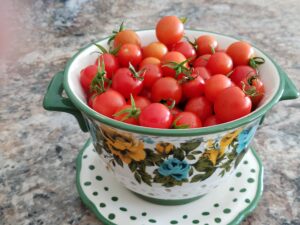
Larry’s cherry tomatoes
The movement to support locally grown foods is a good one, and perhaps it’s also time to consider preserving and storing food again. However, I’m not likely to be pickling beets any time soon.
Almost everyone knows the Lord’s Prayer, but how often do we think about what it means? One line states, “Give us this day our daily bread.” Only when the shelves were empty, did I change that daily prayer. Now I say, “thank you for the incredible amount of food you have blessed us with.”
The Lord’s Prayer
Jesus said, “This, then, is how you should pray:
“‘Our Father in heaven, hallowed be your name, your kingdom come, your will be done, on earth as it is in heaven. Give us today our daily bread. And forgive us our debts, as we also have forgiven our debtors. And lead us not into temptation, but deliver us from the evil one.’”
Matt. 6: 9-13 (NIV)
Writing Update
Like a hummingbird, I flit from writing project to writing project, enjoying the freedom of choosing what to write each day with no deadlines.
Last week I was thrilled to learn the Bismarck Public Library is now offering copies to “Secrets of the Dark Closet” to local book clubs. A list of discussion questions is available with the bag of books. If you are outside of Bismarck and your book club is reading it, contact me for the discussion questions.
All three books are available at all online bookstores and in some local stores. In August, will be restocking for the fall season in the next month.
May God bless you and yours in every way.
Lessons from the Polio Epidemic
www.gaylelarsonschuck.com/blog
What causes it? What will cure it? When will a vaccine be found? Will we get back to normal?
These questions were being asked 70 years ago during the polio epidemic. The answers might be instructive for us today as we deal with Covid-19. Polio was around for a long time, but by 1950, the summer outbreaks were worsening and causing widespread fear.
Mayo Clinic describes polio or Poliomyelitis as “a contagious viral illness that in its most severe form causes nerve injury leading to paralysis, difficulty breathing and sometimes death.” Fear of polio closed businesses and quarantined families. The news reported the number of people infected daily. A desperate search for medical answers was underway. At its peak in the 1950s, the polio epidemic paralyzed over 35,000 people in the U.S. each year, according to the Centers for Disease Control and Prevention.
Polio usually struck in the summer. Most of its victims were children. Until a vaccine was found years later, swimming pools and theaters were closed, and other outside activities came to a halt. Children spent summers in the house, unable to play sports or be with friends.
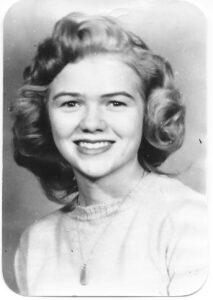
Donna Larson Welander
The disease became personal for my own family when my sister Donna contracted polio in 1952. She was 22, married and living in Nebraska. She had a two-year-old daughter and was pregnant with her second child. Paralyzed from the waist down, Donna spent months in the hospital in Lincoln, Nebraska. Six months later, she miraculously delivered a healthy baby.
A year after being struck, she was sent to Warm Springs, Georgia, for several months for rehab therapy. Although they hoped she would be able to walk with braces and crutches, in the end she opted to use a wheelchair. She learned how to raise children and run a household from her wheelchair, and for the next 32 years she wheeled through life. I never once heard her feel sorry for herself.
Donna was only 53 when she died in 1983. At that time, little was known about post-polio syndrome. Research continues to evolve.
On March 21 this year, a USA Today headline read, “For those who survived polio, coronavirus is eerily familiar. But ultimately, science won.” The story tells how the first vaccine was introduced in 1955. Later, Albert Sabin perfected an oral vaccine which became widely distributed in 1962.
The bad news is that it took decades to find the cause and develop a vaccine that worked. There were many failed attempts. When a vaccine was found, one careless manufacturer accidently gave thousands of children the poliovirus. Today, there is still no cure for polio, although the last case originating in the U.S. was in 1979.
While polio grew into an epidemic over several decades, the coronavirus pandemic has exploded across the world in months. The CDC first announced a mysterious virus on January 21, 2020. On June 23, the United States death toll was at 122,132.

Take time to smell the flowers
Here are some useful take-aways from the polio epidemic:
Think long-term vigilance. It will take time to develop and test an effective vaccine. It may be years before it’s available worldwide. There may be mutations. There may be post-Covid-19 symptoms. We can’t shutter our businesses, schools and churches forever, but we can change our mindset to help minimize its spread.
Find serenity. Take a sabbatical from the pressures of life. Are you an “activity addict”? Author Chuck Swindoll compares our frantic lifestyles to the churning of a washing machine. Perhaps it’s time to slow down and also help our children find serenity. Refresh your spiritual life. Pray, sing, read your Bible.
Respect others. Cover your mouth if you cough or sneeze. Wash your hands and carry a sanitizer. Please forego hugs this year and give people space. I don’t wear a mask, but I am social distancing. It’s awkward when someone wants to hug or stands too close in the grocery line.
Be calm. Folks, we’re in a national medical crisis and it’s a political year. Fear and isolation can do strange things to people. This is not the time for blame games and arguments. Instead, pray for our president, governors and other leaders. They are doing their best in uncharted territory.
Be positive. Good things can come out of hard times. During the polio epidemic, Pres. Franklin Roosevelt helped found the March of Dimes, which helped Jonas Salk advance research that led to the first vaccine. The March of Dimes was the first non-profit to depend on help from small donors. It became the prototype for many other organizations. The combined amount of good they do is immeasurable.
Recommended Reading: I just finished reading I’ll Watch the Moon by Ann Tatlock. It’s a novel set in 1948 that sweeps you into the life of a family that is dealing with the polio epidemic.
Writing Update. With no book-signing events planned, I have a stock of books on hand. If you are interested in a summer deal on signed copies, contact me through the Reply form on the website.
“He has set eternity in the hearts of men.” Eccesiastes 3:11 NIV
The Ice Cream Bar
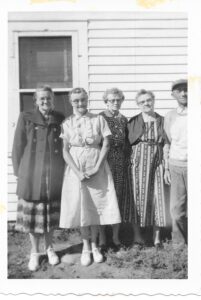
Aunt Emma, Aunt Lillie, my mother Neva, Aunt Mary & my father, Alfred Larson
www.gaylelarsonschuck.com/blog
Today, I bought a box of ice cream bars, and the first bite transported me back to the dusty main street of Dickey, North Dakota.
When I was growing up, my parents often drove to Dickey on Sunday afternoons to see Dad’s family. From our farm, it was a straight shot north on a gravel road. As we drove, the flat land dipped into the fertile James River Valley. Today, the valley, located south of Jamestown, is part of the Chan SanSan Scenic Backway. www.ndtourism.com/best-places/north-dakota. Back then, we just thought it was pretty.
Along the way, we’d pass the farm where Dad’s parents had lived, though they were gone before I was born. The Larsons had arrived at Dickey in 1902. I remember asking Dad how they traveled when they moved from southern Minnesota. With a straight face, he said with a team of oxen. That was a shocking piece of information! I was grown up before I realized he was joking and that settlers of that era arrived by train.
When I was a child, many of his siblings still lived in the area. Sisters Mary, Ella, Emma and Lillie all lived in Dickey at that time.
Dickey is a village of gravel streets and unpretentious houses. Ella lived in a low rambling brown stucco house on the main street, along with Aunt Emma. That is where we generally went to visit. The adults would gather around the round oak dining room table for a late afternoon lunch of coffee and oatmeal cookies or rhubarb cake.
During the summers, kind-hearted Ella took in special needs children from the Grafton State School. Two of the girls visited each summer. Myrna was older and Janice was younger than I was. Since I was the youngest of 43 cousins by several years, I was happy to have them as playmates.
One time, after they’d moved back to Grafton, we went to Dickey on a hot fall Sunday. One of my aunts took pity on me being the only child present and gave me a nickel to go buy ice cream.
It’s hard to believe how sheltered I was as a child. I was seven-years-old and had never been sent off alone in a strange town. Never mind that the town had fewer than a hundred residents. I bravely walked up the street, with the blue sky framed by golden-hewed elm and cottonwood trees, and the hot wind throwing sand at my bare legs.
In my mind, I went to a little general store, but the state’s blue laws were in effect, so it must have been a café. Whatever it was, it had a big front window, a squeaky screen door, a floor fan blowing inside, and a long freezer with a slide door on the top.
 They didn’t have ice cream cones, so I picked out a Cheerio, which I had wanted to try. Plopping my nickel on the counter, I planned to walk back to Aunt Ella’s house before eating it. However, within a minute, ice cream was leaking out of the paper wrapper. I opened it up and began damage control, slurping at the chocolate and vanilla treat and trying not to get any on my clothes. In spite of the mess, it was a memorable treat.
They didn’t have ice cream cones, so I picked out a Cheerio, which I had wanted to try. Plopping my nickel on the counter, I planned to walk back to Aunt Ella’s house before eating it. However, within a minute, ice cream was leaking out of the paper wrapper. I opened it up and began damage control, slurping at the chocolate and vanilla treat and trying not to get any on my clothes. In spite of the mess, it was a memorable treat.
In writing this essay, I began to realize how many memories I have of going to Dickey, and I’m truly surprised to realize how much the towns in my books resemble Dickey.
In By the Banks of Cottonwood Creek and Amber’s Choice, the village of Schulteville was admittedly named after my Aunt Lillie and Uncle Adrian Schulte. At the time of the Cheerio meltdown, they lived in a rambling one-story hot pink house a few blocks from Ella’s. Later they moved to Adrian (yes, Adrian moved to Adrian), which is seven miles west on a road through the pristine valley.
Later they bought a nice house in Dickey, a square two-story stucco house. The attic is as large as any house we ever lived in and a covered porch ran across the front of the house. It still stands across the street from the Methodist church. In my books, Aunt Kate Schulte has the nicest house in Schulteville and it’s located across the street from the church. (Disclaimer, Aunt Kate Schulte is nothing like my sweet Aunt Lillie.)
And finally, I’m happy to say ice cream bars still taste as good today as on that long ago day in Dickey.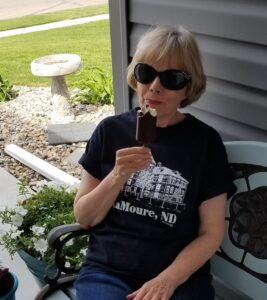
A Special Word of Encouragement
Friends, I hope this look back brightens your day. We live in difficult times and it’s easy to be overwhelmed by the problems we face. When that happens, we need to do what Colossians 3:2 states: “Set your minds on things above, not on earthly things.” NIV. When our focus is on the Lord and the power of his might, it’s easier to trust him to see us through. Philippians 4 has a lot of advice on how to get through these times. It was written by Saint Paul when he was in prison, but his words are still of value today!
Writing Update
I am writing and meeting with my writers group each week, using social distancing, of course. My books are available online or get signed copies by contacting me.
Gale Andrew Muir 1884-1957
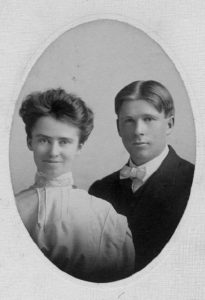
Bessie & Gale Muir married in 1907
This year, the anniversary of Grandpa Gale Muir’s death falls during Memorial Day Weekend. He died on May 23, 1957, sixty-three years ago. A stroke five years earlier had restricted his speech and movement and Grandma Bessie had cared for him at home.
When he died, they were a few months short of celebrating their 50th wedding anniversary. They had eight living children and 29 grandchildren.
What was Grandpa Gale like? His son, Wallace Muir, described him as “generous to a fault with his time and talents.” He was a skilled craftsman and a carpenter. Wallace also said that he enjoyed playing with his older grandchildren and telling them stories he learned from his grandfather. By the time I came along, he could no longer speak, but, oh, how I wish I’d heard some of those stories.
On May 27, 1957, the day of Grandpa Gale’s funeral, the adults decided that the younger grandchildren should stay at the house during the funeral. Only Judy, who was about nine, attended the service.
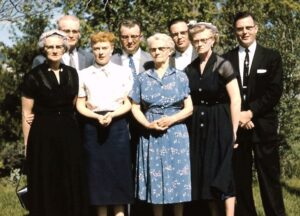
Bessie Muir and her children, l to r: Margaret, Don, Better, Bob, Wallace, Neva & Willis. Aileen is not pictured
Why would they exclude the grandchildren from an important occasion like this? My guess is they expected an overflowing crowd at the small Presbyterian Church. Gale had a wonderful dry wit, enjoyed hunting, and came had a large family. Likely, everyone in town turned out to pay their respects.
Leaving a dozen squirmy kids at Grandpa and Grandma’s house simplified things. For the record, it was a beautiful May day. We were strictly told not to leave the yard, and not to go into the house unless we had to go potty.
I have two memories of the day. During the funeral, we cousins forgot our sadness and began playing together in the yard. We were running and screaming with abandon when we suddenly realized a parade of cars was slowly driving by. We stopped and stood as silent and solemn as statues to watch the hearse that carried our Grandpa Muir from the church to Rosehill Cemetery.
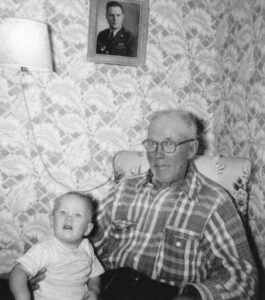
Granddaughter Jayne Muir with Gale
The second memory happened toward the end of the day when I was ushered into the living room to meet Grandpa’s siblings. As Grandpa Gale was the youngest in their family, many of them must have been in their seventies. They had traveled over 350 miles from Jackson, Minnesota. I had never met any of them before. I remember the ladies holding my hand and peering at me.
Of course, at seven I didn’t understand the significance of the moment. Now having lost my own siblings, I get it. They wanted to meet their brother’s offspring. Perhaps they were looking for some of Gale in the young faces brought before them. Some of my cousins have the Muir eyes, chin or red hair. I don’t, but I was named after him.
Today, Gale and Bessie have six or seven generations of descendants. Happily, Gale’s red hair still shows up randomly when a new baby is born.
Writing Update
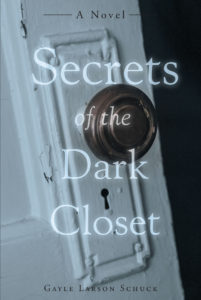 Gale and Bessie’s love story is the topic of my book, Secrets of the Dark Closet. I recently republished it, which means it is less expensive! However, it also means there are no Amazon reviews for it. If you order a copy from Amazon, please write a review. Even a short one helps with the algorithms. The book is available online, through your local bookstore, or contact me for a signed copies.
Gale and Bessie’s love story is the topic of my book, Secrets of the Dark Closet. I recently republished it, which means it is less expensive! However, it also means there are no Amazon reviews for it. If you order a copy from Amazon, please write a review. Even a short one helps with the algorithms. The book is available online, through your local bookstore, or contact me for a signed copies.
The Last Kindergarten Show
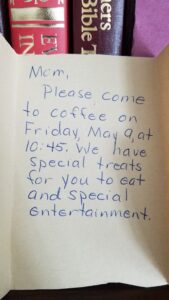 Every mother knows the moment. You’re proud and happy that your child is growing up, and yet you aren’t ready to let him go. That’s how I felt when our younger son graduated from kindergarten many years ago.
Every mother knows the moment. You’re proud and happy that your child is growing up, and yet you aren’t ready to let him go. That’s how I felt when our younger son graduated from kindergarten many years ago.
This week I found an old invitation to a May party for mothers that brought up a lot of memories. I wrote an essay after that emotion-laden party. Here it is, in honor of all mothers:
Two dozen five-year-olds march in a circle to the music, then swish in and out. They are silently absorbed in following the rhythm of the record player.
I sit on a teeny-tiny chair wringing the sopping shred of tissue in my hand and cringing away from the rest of the audience. Breathing deeply, I try to gain composure and keep the cry in my throat from escaping.
The music stops and everyone claps. I smile hugely so anyone glancing my way will see my teeth and not my tears. How could my baby learn all of those dance steps? Why hadn’t I seen this grownup side of him before? He even danced with a girl and held her hand. Where had this maturity been hidden?
The kids reassemble, sitting on a rug in a semi-circle. They begin to sing the songs they’ve been practicing. My son is keeping an eye on me through a maze of chair legs as he half-heartedly sings. I smile and he waves.
All week, he’s been telling me about the menu for what he calls “the last kindergarten show.” The kids have done the cooking. I think of how he described the recipe for peanut butter balls. “First you mix up peanut butter and some kind of funny sugar and rotten potatoes.”
“Rotten?” I’d asked.
“Yes, and you have to smash them too. And then you roll them between your hands like this.”
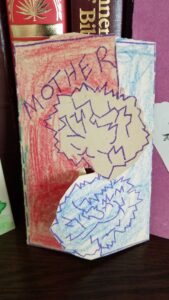 The room smells like a mixture of crayons, paste and paper. Not unlike the blue-crayon carnation invitation I received last week. Twenty years ago, they were using the same mimeographed pattern. How had that managed to stay the same in this turbulent world? Would it be in use twenty years from now?
The room smells like a mixture of crayons, paste and paper. Not unlike the blue-crayon carnation invitation I received last week. Twenty years ago, they were using the same mimeographed pattern. How had that managed to stay the same in this turbulent world? Would it be in use twenty years from now?
My son gets up and leans casually on the piano for the last song, while the others stand facing him. The song is about snowmen. In the last line, the sun comes out and melts them. He hops off the piano bench beaming rays of sunlight on the others and they sink to the floor, melted.
I am melting, too, as I wonder if I’m ready for a new phase of life. In a few short months, he will be off to first grade, but what will I be doing? He seems very well prepared for what lies ahead. Am I?
This is the last of a long line of kindergarten shows and I greedily drink in every moment of it, regretting that there will never be another. My nose is a tattletale red, showing the emotional journey I’ve been on for the past hour.
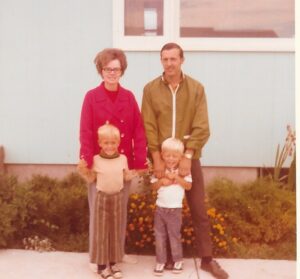
Our family ‘way back then
The songs are over and there is much applause. The kids pass out handmade Mother’s Day cards. Mine is made of yellow construction paper. The word “love” is on one side and his name on the other. It’s very well glittered. When it becomes apparent that other mothers are getting two or even three cards, he lets me know he only made one, but he used lots of glitter.
And lots of love, I think to myself. We hold hands as we walk out under a banner of watercolor flowers, out into the brightness of a May day.
At home, the soup boils over, the phone rings, and my husband rattles off a list of errands that must be run. But for one fleeting moment, I hold in the palm of my hand a carefully printed nametag that reads, “mY Momm.”
Happy Mother’s Day to all women
who nurture and care for others.
